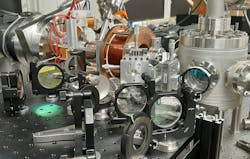Femtosecond and attosecond laser light is a common feature of modern physics labs, but it turns out electrons can match or maybe even surpass these sources when it comes to exploring ultrafast dynamics—by not only offering similarly short pulse durations but also providing a way to see the atoms in real space, akin to an electron microscope.
Maxim Tsarev, Johannes Thurner, and Peter Baum, physicists at the University of Konstanz, built an experimental setup to convert an electron beam into pulses of merely attosecond duration (see figure). By using paired femtosecond laser pulses, they compressed a series of electron pulses within a free-space beam to a numerically analyzed duration of five billionths of a nanosecond—achieving one of the shortest signals produced by scientists so far.
The team’s work is inspired by time. “Time is one of the most fascinating dimensions of nature: Everything takes time, and time is irreversible,” says Baum, a professor of physics and head of the Light and Matter Group at the University of Konstanz. “One of the most immediate questions is: How fast is fast? And is there eventually a limit at which objects don’t move from here to there as we intuitively think of them?”
Controlling electrons in time
To capture extremely fast processes in space and time, the team needed to build their camera beyond the limits of a material. While many scientists use short laser pulses, they opted for electrons instead because electrons have a rest mass and a much shorter matter wavelength than optical or x-ray light.
To create their camera, they spent months repairing a 20-year-old electron energy spectrometer in the basement and then attached it to their electron diffraction beamline.
Once they got it hooked up, they aligned all three pulsed beams in space and time—at two angles. “Eight parameters must match quite precisely before any signals can be observed,” says Baum. “I was happy when it finally happened and the interference fringes showed up almost exactly as we predicted.”
Which physics concepts underpin this work? Multiple light waves can superimpose to create almost any type of wave crests and troughs. So the team searched for combinations of incidence angles and frequencies so that the co-propagating electrons, which fly through vacuum at half the speed of light, overlap with the optical wave crests and troughs at the exact same speed.
A nonlinear force that drives positive and negative particles in the same direction then pushes the electrons in the direction of the next wave trough. After this short interaction, a series of electron pulses are generated that are extremely short in time, particularly within the middle of the pulse train where the accumulated electric fields are close to zero.
For a brief time, the temporal duration of the compressed electron pulses is a mere five attoseconds. To understand this, the team measures the electrons’ remaining velocity distribution after compression.
Quantum effects
For Baum, even more important than making the shortest pulses are the quantum effects it enabled them to discover: Electrons, which are matter waves, can be coherently controlled by two photons of laser light—and one photon isn’t enough.
Quantum mechanically, what’s going on is a temporal superposition (interference) of electrons with themselves after they experience the same acceleration at different times. This effect is important for quantum mechanical experiments, such as the interactions of electrons and light.
While plane electromagnetic waves like a light beam normally can’t cause permanent velocity changes of electrons within a vacuum, two photons simultaneously traveling in a wave slower than the speed of light solve this problem (Kapitza-Dirac effect).
Seeing ultrafast dynamics in space and time
In principle, the scientists can turn electrons into even shorter pulses by using more intense laser light. “But we’ve already achieved pulses that are among the shortest events ever created, although our pulses still need to be synchronized to an excitation event to become fully applicable to pump-probe investigations,” says Baum.
When a material is hit by two short pulses at a variable time interval, the first pulse can trigger a change and the second pulse can be used for observation like the flash of a camera. In principle, lasers of any power can be used to enable stronger compression in the future.
“We’ll make ever-shorter electron pulses and also keep searching for their quantum effects,” says Baum. “Eventually, we’ll discover the motion of electrons within an atom or maybe even the space-time dynamics of inner-nuclear reactions. I’m looking forward to these discoveries.”
FURTHER READING
M. Tsarev, J. W. Thurner, and P. Baum, Nat. Phys. (2023); https://doi.org/10.1038/s41567-023-02092-6.

Sally Cole Johnson | Editor in Chief
Sally Cole Johnson, Laser Focus World’s editor in chief, is a science and technology journalist who specializes in physics and semiconductors. She wrote for the American Institute of Physics for more than 15 years, complexity for the Santa Fe Institute, and theoretical physics and neuroscience for the Kavli Foundation.
